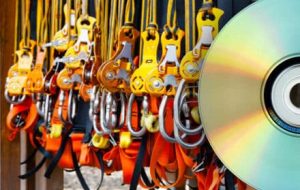Servicing of Multi-Piece and Single-Piece Rim Wheels
Home More Training Resources OSHA General Industry Training Requirements Servicing of Multi-Piece and Single-Piece Rim Wheels
OSHA Training Requirements - Servicing of Multi-piece and Single-piece Rim Wheels
This website is not the official or final authority to determine OSHA compliance responsibilities, which are set forth in OSHA standards themselves, and the Occupational Safety and Health Act of 1970. Because OSHA regulations are constantly being added, deleted, and/or revised, you must not rely on this website as the official or final authority of OSHA training requirements; refer to the official OSHA regulations available on OSHA’s website (osha.gov). – See disclaimers.
1910.177 – Servicing of Multi-Piece and Single-Piece Rim Wheels
(c) – Employee training.
(1) – The employer shall provide a program to train all employees who service rim wheels in the hazards involved in servicing those rim wheels and the safety procedures to be followed.
(i) The employer shall assure that no employee services any rim wheel unless the employee has been trained and instructed in correct procedures of servicing the type of wheel being serviced, and in the safe operating procedures described in paragraphs (f) and (g) of this section.
(ii) Information to be used in the training program shall include, at a minimum, the applicable data contained in the charts (rim manuals) and the contents of this standard.
(iii) Where an employer knows or has reason to believe that any of his employees is unable to read and understand the charts or rim manual, the employer shall assure that the employee is instructed concerning the contents of the charts and rim manual in a manner which the employee is able to understand.
(2) – The employer shall assure that each employee demonstrates and maintains the ability to service rim wheels safely, including performance of the following tasks:
(i) Demounting of tires (including deflation);
(ii) Inspection and identification of the rim wheel components;
(iii) Mounting of tires (including inflation with a restraining device or other safeguard required by this section);
(iv) Use of the restraining device or barrier, and other equipment required by this section;
(v) Handling of rim wheels;
(vi) Inflation of the tire when a single piece rim wheel is mounted on a vehicle;
(vii) An understanding of the necessity of standing outside the trajectory both during inflation of the tire and during inspection of the rim wheel following inflation; and
(viii) Installation and removal of rim wheels.
(3) – The employer shall evaluate each employee’s ability to perform these tasks and to service rim wheels safely, and shall provide additional training as necessary to assure that each employee maintains his or her proficiency.
(f) – Safe operating procedure – multi-piece rim wheels. The employer shall establish a safe operating procedure for servicing multi-piece rim wheels and shall assure that employees are instructed in and follow that procedure. The procedure shall include at least the following elements:
(1) – Tires shall be completely deflated before demounting by removal of the valve core.
(2) – Tires shall be completely deflated by removing the valve core before a rim wheel is removed from the axle in either of the following situations:
(i) When the tire has been driven underinflated at 80% or less of its recommended pressure, or
(ii) When there is obvious or suspected damage to the tire or wheel components.
(3) – Rubber lubricant shall be applied to bead and rim mating surfaces during assembly of the wheel and inflation of the tire, unless the tire or wheel manufacturer recommends against it.
(4) – If a tire on a vehicle is underinflated but has more than 80% of the recommended pressure, the tiremay be inflated while the rim wheel is on the vehicle provided remote control inflation equipment is used, and no employees remain in the trajectory during inflation.
(5) – Tires shall be inflated outside a restraining device only to a pressure sufficient to force the tire bead onto the rim ledge and create an airtight seal with the tire and bead.
(6) – Whenever a rim wheel is in a restraining device the employee shall not rest or lean any part of his body or equipment on or against the restraining device.
(7) – After tire inflation, the tire and wheel components shall be inspected while still within the restraining device to make sure that they are properly seated and locked. If further adjustment to the tire or wheel components is necessary, the tire shall be deflated by removal of the valve core before the adjustment is made.
(8) – No attempt shall be made to correct the seating of side and lock rings by hammering, striking or forcing the components while the tire is pressurized.
(9) – Cracked, broken, bent or otherwise damaged rim components shall not be reworked, welded, brazed, or otherwise heated.
(10) – Whenever multi-piece rim wheels are being handled, employees shall stay out of the trajectory unless the employer can demonstrate that performance of the servicing makes the employee’s presence in the trajectory necessary.
(11) – No heat shall be applied to a multi-piece wheel or wheel component.
(g) – Safe operating procedure-single piece rim wheels. The employer shall establish a safe operating procedure for servicing single piece rim wheels and shall assure that employees are instructed in and follow that procedure. The procedure shall include at least the following elements:
(1) – Tires shall be completely deflated by removal of the valve core before demounting.
(2) – Mounting and demounting of the tire shall be done only from the narrow ledge side of the wheel. Care shall be taken to avoid damaging the tire beads while mounting tires on wheels. Tires shall be mounted only on compatible wheels of matching bead diameter and width.
(3) – Nonflammable rubber lubricant shall be applied to bead and wheel mating surfaces before assembly of the rim wheel, unless the tire or wheel manufacturer recommends against the use of any rubber lubricant.
(4) – If a tire changing machine is used, the tire shall be inflated only to the minimum pressure necessary to force the tire bead onto the rim ledge while on the tire changing machine.
(5) – If a bead expander is used, it shall be removed before the valve core is installed and as soon as the rim wheel becomes airtight (the tire bead slips onto the bead seat).
(6) – Tires may be inflated only when contained within a restraining device, positioned behind a barrier or bolted on the vehicle with the lug nuts fully tightened.
(7) – Tires shall not be inflated when any flat, solid surface is in the trajectory and within one foot of the sidewall.
(8) – Employees shall stay out of the trajectory when inflating a tire.
(9) – Tires shall not be inflated to more than the inflation pressure stamped in the sidewall unless a higher pressure is recommended by the manufacturer.
(10) – Tires shall not be inflated above the maximum pressure recommended by the manufacturer to seat the tire bead firmly against the rim flange.
(11) – No heat shall be applied to a single piece wheel.
(12) – Cracked, broken, bent, or otherwise damaged wheels shall not be reworked, welded, brazed, or otherwise heated.

On Site OSHA Training Classes

Online OSHA Training Courses

